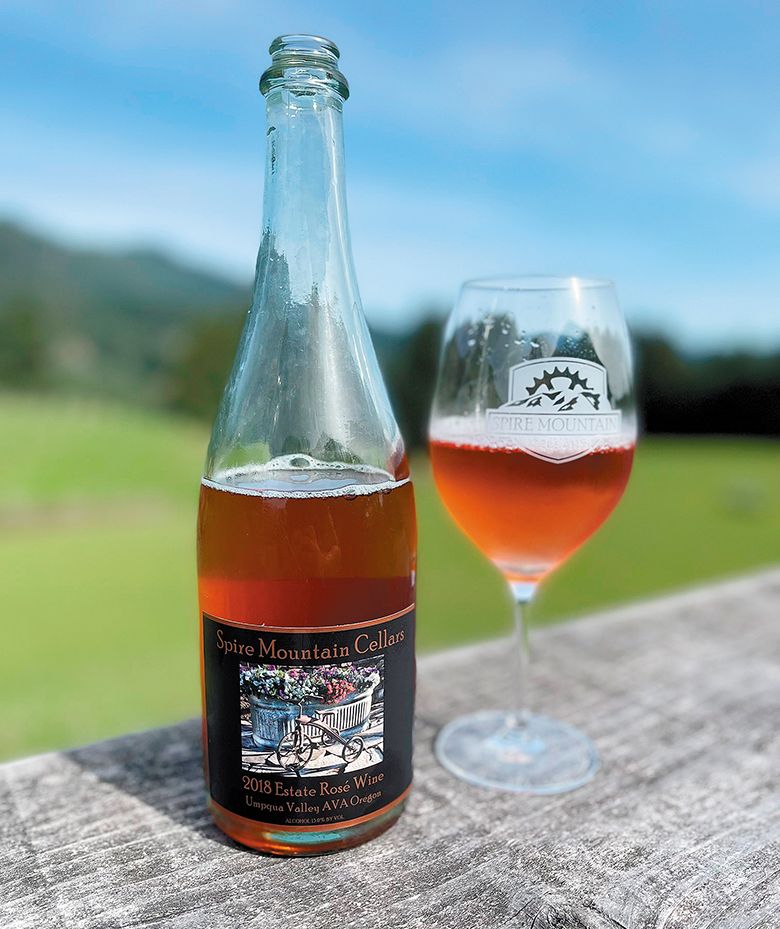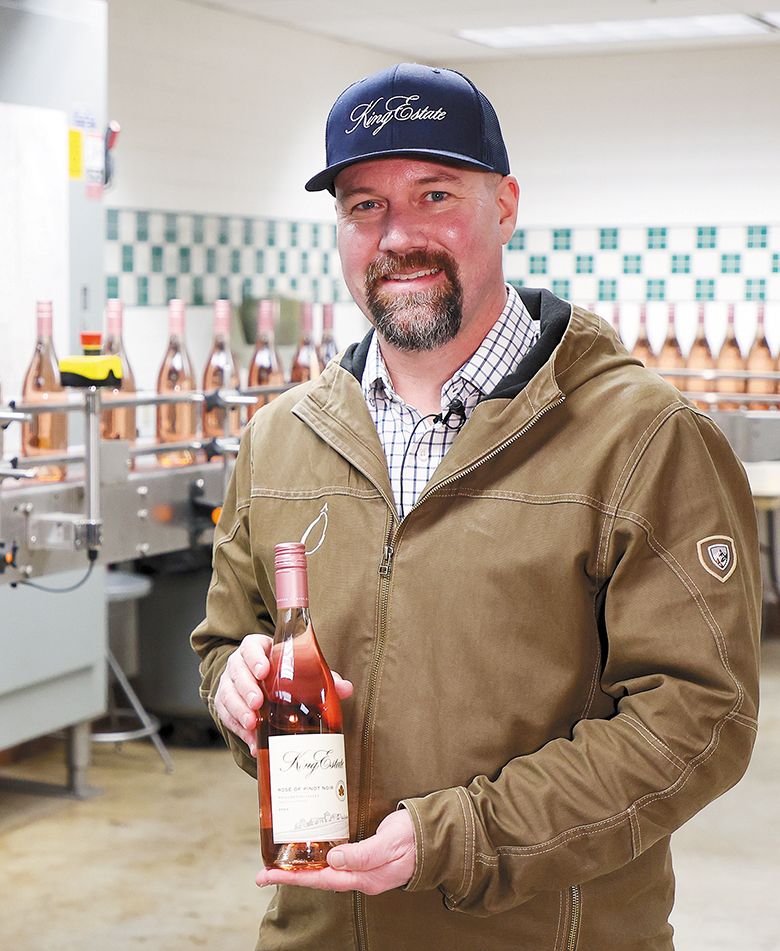Bleeding Beauty
The saignée method results in a vibrant, complex rosé


By Aakanksha Agarwal
Rosé often conjures images of a poolside glass of something bright and easy. Light pink wine personifies summer. But, behind that blush is a world of technique and timing– especially for those made using the saignée method.
This centuries-old French method transforms juice from red fermentations into something richer, deeper and more structured than the conventional pale pink Provençal style.
Saignée (pronounced “sohn-YAY”) literally means “to bleed.” When making red wine, once the grapes are crushed and left to macerate (soak on their skins), some winemakers remove a portion of the pinkish juice during the first hours of fermentation. This not only concentrates the red wine by increasing the skin-to-juice ratio, intensifying color, tannin and flavor but also creates a rosé from the bled juice. Fermenting off the skins produces a lighter, brighter wine with distinct characteristics from the red grape.
Unlike direct-press rosé, where grapes are immediately pressed after harvest to produce a pale, crisp style, saignée rosé receives extra time on the skins. This practice imparts additional phenolic compounds, thereby enhancing the body, mouthfeel and color. This style forms a bridge between delicate rosé and a light red, perfect for serious rosé lovers and versatile food pairings.
More than just a by-product of red wine production, saignée rosé is a deliberate craft for many winemakers. This method highlights vintage character, manages ripeness and shapes both their red and rosé programs in a single, yet elegant manner.
Let’s step into the cellars of several Northwest wineries to learn how and why they make saignée rosé.
Finding Balance in Oregon’s Cool Climate
Terry Culton, Willamette Valley Vineyards
At Willamette Valley Vineyards, Terry Culton believes saignée offers a chance to highlight Oregon’s hallmark grape: Pinot Noir. “We use a combination of direct-press and saignée when crafting our Whole Cluster Rosé of Pinot Noir,” Culton explains. Willamette’s Whole Cluster rosé focuses on whole berry direct press with saignée as a finishing accent to fine-tune both texture and flavor.
Ideal for Pinot Noir with its long, sunny days and cool nights, the Willamette Valley enables gradual ripening and layered fruit development.
“Our cooler climate allows a wider window to pick fruit at optimum levels. We can harvest Pinot Noir grapes with lower sugar content,” Culton says. The result: reduced potential alcohol and increased flexibility when creating balanced rosés without overly boozy notes.
He emphasizes “a saignée rosé isn’t merely a by-product when making a better Pinot. It can be a very distinct, full-bodied blend.” By combining saignée and press fractions from the same Pinot Noir lots, Culton creates a rosé with both elegance and complexity. “We achieve the best blend for us,” he adds. “It’s 100 percent Pinot Noir.”
This technique provides precise control over color and mouthfeel, important elements in crafting a rosé considered more than a fleeting summer sipper.
Tuning the Red, Revealing the Rosé
Stewart Boedecker, Boedecker Cellars
While Culton considers the saignée method an integrated part of his rosé program, Stewart Boedecker at Portland’s Boedecker Cellars uses it to enhance his red winemaking.
“We utilize the saignée method primarily to fine-tune the skin-to-juice ratio during our Pinot Noir fermentations,” Boedecker notes. In warm vintages or with certain vineyard blocks, the juice-to-skin ratio can affect the extraction of color, tannins and flavor. By “bleeding” off some juice early, he achieves the desired concentration in his red wines.
But the resulting rosé, called “Reflection,” becomes a bonus for rosé lovers. “If we want higher concentration, we draw off juice from the fermenter within the initial 2-3 hours,” Boedecker explains. This short skin contact imparts delicate notes of strawberry and cherry without harsh tannins. “It’s all about finding the sweet spot where the juice is aromatic but not too grippy,” he adds.
Boedecker’s approach to aging further influences the final wine. He enhances the mouthfeel without introducing overt oak flavors by resting the rosé in neutral oak barrels, previously used for Chardonnay. “Our Pinot Noir rosé doesn’t usually go through malolactic fermentation,” he adds. “We prefer the lively character and crispness achieved by retaining much of the malic acid.” Reflection conveys an early snapshot of the vintage, leaning towards strawberry some years, and cherry in others.
Ripeness Management in Warm Climates
John Patterson, Patterson Cellars
Washington’s wine regions like Red Mountain, Yakima Valley and Walla Walla, are known for warm days and high sugar accumulation. This can push potential alcohol levels into the 16 percent range, challenging for balance in both reds and rosés. John Patterson at Patterson Cellars in Walla Walla sees saignée as a critical step in ripeness management.
“Many of the AVAs we source from are warmer growing regions,” Patterson observes. “To achieve the desired varietal characteristics in our red wines, we allow the fruit to hang longer on the vine.” But riper grapes have higher sugar levels and the potential for increased alcohol. The saignée method provides an ideal solution. “We remove juice early in the fermentation process before any water is added,” he explains. That juice is vibrant, packed with varietal expression… and much too flavorful to discard.
“While the juice comes from red wine production, we approach it as an intentional rosé,” Patterson emphasizes. His saignée rosé often includes Bordeaux varietals Cabernet Sauvignon, Merlot and Cabernet Franc– each contributing depth, structure and a broader aromatic profile. To manage tannins, Patterson Cellars uses Vegecoll, a natural fining agent derived from potatoes, which softens the wine without compromising its character. “Depending on the vintage, we may leave a touch of residual sugar to balance the structure,” Patterson notes. This step helps tame tannins and maintain fruit-forward freshness.
Skin Contact in Moderation
Brent Stone, King Estate Winery
Brent Stone at Eugene’s King Estate Winery believes saignée is a bridge between the complexity in a red wine and freshness in a white wine.
Stone offers a concise primer on rosé winemaking by highlighting the dual nature of saignée: a red wine technique producing a fresh, pink wine. “This rosé winemaking process simply adds a small amount of skin contact, similar to a red wine,” he explains, “thereby introducing color and additional structure.”
Once the desired elements are achieved, the juice is fermented off the skins in stainless steel tanks, like a white wine, preserving delicate aromas and bright fruit. Stone’s rosé of Pinot Noir is all about vibrancy and freshness, perfect for summer grilling. “It’s extremely versatile, pairing well with many dishes– cheeses, lighter salads, grilled chicken and salmon,” he asserts. “Drink it with burgers, ribs or pulled pork… the fruit complements grilled and smoky flavors while the acid balances high-fat dishes.”
Blending Varietals for Depth
Kevin Kohlman, Spire Mountain Cellars
Kevin Kohlman at Spire Mountain Cellars, in the hamlet of Oakland, approaches his rosé with playful flexibility, while also employing technical precision. “My saignée rosé is a blend of three varietals,” he notes. “It’s dictated primarily by the Grenache ripeness, currently 60 percent, while Cabernet Franc is another 30 percent and the remainder is Pinot Noir. The percentages shift, depending on the weather and how the grapes look.” Each varietal has its own tannin profile, color potential and aromatic signature, making blending decisions crucial.
“I use the saignée method, immediately pulling in all three varietals,” Kohlman adds. “I keep each pressing separate.” Press fractions are different streams of juice extracted at varying pressure, each with its own intensity of color, phenolics, tannins and flavor. “Then, as fermentation progresses, I may add extra pressings,” he explains. This flexibility allows for precise color and texture, ensuring the desired rosé each vintage.
For Kohlman, saignée rosé is a canvas for food. “My favorite pairing is fresh sockeye salmon with white rice and asparagus,” he shares. “I cook the asparagus in the air fryer so it’s crispy on the outside and soft on the inside.” His rosé, with its bright citrus and berry notes, balances the richness of the grilled fish and the tangy brightness of capers and lemon. “Almost any grilled fish is an excellent match with that rosé,” Kohlman observes.
Whether light and floral or bold and structured, saignée rosé proves pink wine is anything but simple.
Aakanksha Agarwal is a wine, travel and lifestyle writer from India. Formerly a Bollywood stylist, she now resides in the U.S., embracing writing full-time while juggling family life and indulging in her passions for cuisine, literature and wanderlust.










